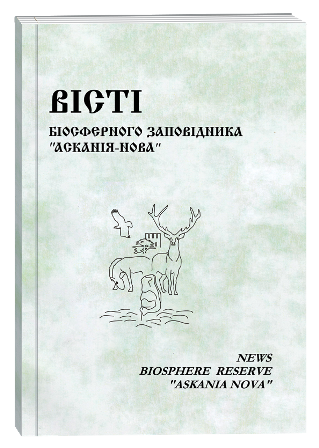CAUSES AND CONSEQUENCES OF DIEBACK OF FRAXINUS EXCELSIOR L. IN THE DENDROPARK "OLEXANDRIA" OF THE NAS OF UKRAINE
DOI:
https://doi.org/10.53904/1682-2374/2019-21/51Keywords:
ДендропаркAbstract
The results of the study of the dynamics and causes of the dieback of Fraxinus excelsior in the landscapes of the Olexandria arboretum are presented. A focus of weakening F. excelsior with a symptom complex of signs characteristic of the disease Chalara fraxinea caused by the invasive fungus Hymenoscyphus fraxineus (T. Kowalski) Baral was discovered in the eastern part of the park in 2011. The dieback of the affected trees began in 2015. Since then, there has been a significant expansion of the focus and the emergence of new focuses in the northern and western directions. During this time (since 2015), 170 trees of F. excelsior with signs of disease fell. Of these, 128 were dried, and 52 died from windbreaks, indicating a significant defeat of Hymenoscyphus fraxineus infected with root rot, mostly honey. Another 44,7% of trees in the area of research have signs of lesion of bataric necrosis. Other diseases such as rotten (11,7% of trees), necrosis-cancerous diseases (3,4%), bacterial (4,9%) were found in the F. excelsior forest stands. The frost victims were affected by 1,4% of trees. Mistletoe was found in 4,9% of trees. At the moment, the dieback is chronic and, apparently, caused by a set of features, the key of which is Chalara fraxinea. There is a very weak recovery and an incomplete age structure of F. excelsior in the focuses of dieback. The massive dieback of F. excelsior in the park will lead to the destruction of landscape compositions, the change of dominant rocks, and the demotion processes in the age-old oak wood.
References
Гойчук А. Ф., Дрозда В. Ф., Кульбанська І. М. Туберкульоз ясена звичайного у західному Поділлі України: етіологія, симптоматика, патогенез. Наукові праці Лісівничої академії наук України. 2018. Вип. 16. С. 31–39.
Давиденко Е. В. Основные причины массового усыхания ясеня в центральных и восточных областях Украины. Известия Санкт-Петербургской лесотехнической академии. 2015. Вып. 211. С. 147–160.
Давиденко К. В., Мєшкова В. Л., Кузнєцова Т. Л. Поширення Hymenoscyphus pseudoalbidus – збудника всихання ясена у лівобережній Україні. Лісівництво і агролісомеліорація : зб. наук. праць. 2013. Вип. 123. С. 143–150.
Драган Н. В., Пидорич Ю. В. Фітопатологічний стан Fraxinus excelsior L. в дендрологічному парку "Олександрія" НАН України. Науковий вісник Національного університету біоресурсів і природокористування України. Серія "Лісівництво та декоративне садівництво". 2016. Вип. 255. С. 100–107.
Журавлев И. И. Диагностика болезней леса. Москва, 1962. 194 с.
Звягинцев В. Б., Сазонов А. А. Массовое усыхание ясеня обыкновенного в Белорусии. Грибные сообщества. Москва, 2012. С. 165–167.
Лоситский К. В. Феномен угнетения лиственных лесов. Лесоведение. 1975. № 3. С. 40–44.
Мацях І. П., Крамарець В. О. Всихання ясена звичайного (Fraxinus excelsior L.) на Заході України. Наук. вісник НЛТУ України. 2014. Вип. 24.7. С. 67–74.
Мєшкова В. Л., Давиденко К. В., Бережненко Ж. І. Комахи-листогризи на ясені (Fraxinus sp.) у зелених насадженнях Харківщини. Захист рослин у ХХІ ст.: проблеми та перспективи розвитку. Харків : ХНАУ, 2013. С. 71–74.
Новак Л. В., Мєшкова В. Л., Гамаюнова С. Г. Біологічні особливості строкатого ясеневого лубоїда Hylesinus varius (F.) у Харківській області. Лісівництво і агролісомеліорація. 2008. Вип. 112. С. 255–260.
Рекомендации по проведению лесопатологических обследований ясеневых насаждений и лесопатологического надзора за инфекционным некрозом ясеней. Минск, 2015. 16 с.
Старк В. Н. Руководство по учёту повреждений леса (с определением). 2-е изд. Москва–Ленинград : Гос. изд-во с.-х. и колхозно-кооперативной литературы, 1932. 408 с.
Шабунин Д. А., Семакова Т. А., Давиденко Е. В., Васаитис Р. А. Усыхание ясеня на территории памятника природы "Дудергофские высоты", вызванное грибом Hymenoscyphus pseudoalbidus, и морфологические особенности его аскоспор. Труды Санкт-Петербургского НИИ лесного хозяйства. 2012. № 1–2. С. 70–79.
Chalara dieback of ash (Chalara fraxinea) [Electronic resource]. Mode of access: http: //www. forestry. gov. uk/ chalara (Date of acces: 14.07. 2018).
Davydenko K., Vasaitis, R., Stenlid J., Menkis A. Fungi in foliage and shoots of Fraxinus excelsior in eastern Ukraine: a first report on Hymenoscyphus pseudoalbidus. For. Path. 2013, Vol. 43. P. 462–467.
Kowalski T. Czekaj А. Symptomy chorobo weigrzybyna zamierających jesionach (Fraxinus excelsior L.) w drzewostanach Nadleśnictwa Staszòw. Leśne Prace Badawcze (Forest Research Papers). 2010. Vol. 71 (4). P. 357–368.
Gross A., Grünig, C. R., Queloz V., Holdenrieder O. A molecular toolkit for population genetic investigations of the ash dieback pathogen Hymenoscyphus pseudoalbidus. Forest Pathology. 2012а, Vol. 42. Р. 252–264.
Gross A., Zaffarano P. L., Duo A., Grünig C. R. Reproductive mode and life cycle of the ash dieback pathogen Hymenoscyphus pseudoalbidus. Fungal Genet. Biology. 2012б. Vol. 49. Р. 977–986.
Gross A., Holdenrieder O., Pautasso M., Queloz V., Sieber T. N. Hymenoscyphus pseudoalbidus, the causal agent of European ash dieback. Molecular Plant Pathоlogy. 2014. Vol. 15 (1). P. 5–21.
McKynney L. V., Thomsen I. M., Kjaer E. D., Bengtsson S. B. K., Nelsen L. R. Rapid invasion by an aggressive pathogenic fungus (Hymenoscyphus pseudoalbidus) replaces a native decomposer (Hymenoscyphus albidus): a case of local cryptic extinction? Fung al Ecology. 2012. Vol. 5. P. 663–639.







